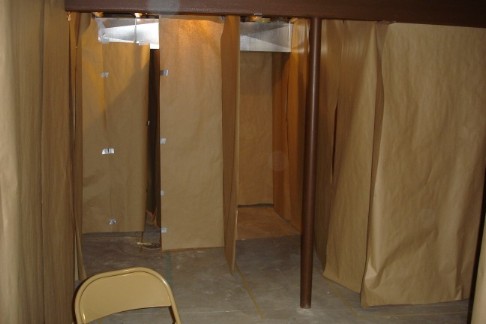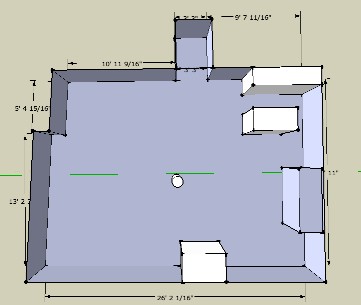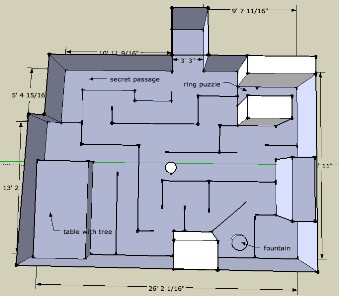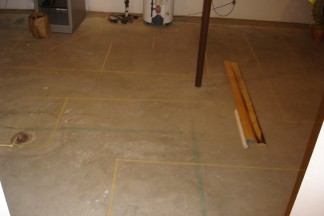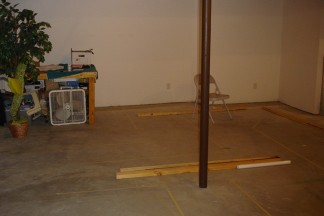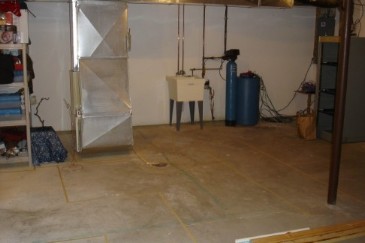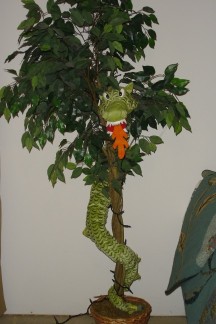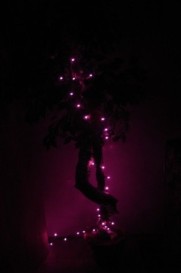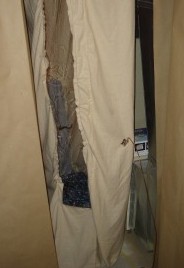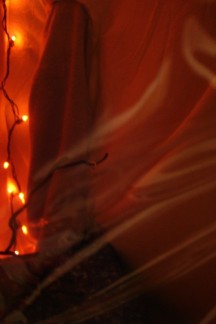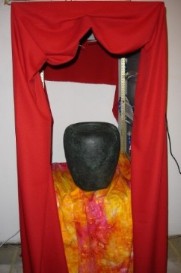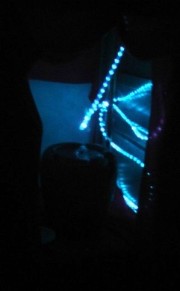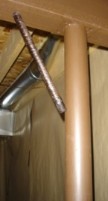WARNING: This game is the ancestor of the Clerical Error game written more recently by Kathleen De Smet. The newer game has undergone heavy revision. If you read this game you will both spoil some secrets and end up with some wrong information.
The center of the maze on Saturday afternoon.
A few things came down and had to be fixed before the Saturday run.When we first decided on the basic idea for Clerical Error, one of the first things I suggested was that we have a maze. I'd had some experiences running around inside full sized mazes before. At one point the Baltimore Science Center put up a tarp and metal pipe maze in about a 20 ft square space that the challenged visitors to map. The Freedmans built a three dimensional maze, often called the cube, which they have used in several of their games. I figured we had the Obarski's sizable basement to work with, and since it was mostly empty, and we should be able to cram quite a lot of maze in there.
Before I had accurate measurements of the basement I tried to start planning out how I would design it. I did some research on maze design and was saddened to find a scant few pages about designing mazes online. I think I got the most help out of Jo Edkins' maze design page, though this page also has a good summary of the types of mazes out there.
In essence there are three types of mazes that I considered making are:
- One path maze - There are no real branches, just one long path that winds around (example).
- Branching maze - There are lots of branches, but only one way to get from the beginning to the end (example).
- Many path maze - These mazes have multiple branches and multiple paths which can lead from the beginning to the end of the maze (example). I think I might have seen these called island mazes somewhere.
Drawing of the empty basement.Of course it's also possible to make three dimensional mazes or any of the two dimensional mazes with some three dimensional bridges to complicate them. The first two types I listed, one path and branching, can be easily solved with the left hand rule. I doubt any D&D player worth their salt is ignorant of this rule, but just in case you aren't a D&D fan, the left hand rule means that if a person in the maze places their hand on the left wall and follows it along, they will eventually reach the end of the maze.
The maze, after much revision.I designed a few example mazes and found that it wasn't too bad, once I had some idea of the size and requirements I needed to work with. I got my friends to measure the basement space (minus immovable obstacles), but I still had the problem of what software to use when designing the maze. I tried various free drawing and drafting software, but had a terrible time finding something that would translate to and from real distances easily. Eventually I tried Sketchup and while it was not everything I wanted, it would do a serviceable job for free. Sketchup had been recently acquired by Google, but the Mac version was not yet available.
The taped maze floor.Unfortunately the lack of a Mac version meant that I was forced to do most of my design work on my boyfriend's Windows desktop machine. This was not optimal, since it meant stealing the machine from him for hours at a time.
The taped maze floor.When I started out I estimated that the smallest reasonable corridor distance I could use was between 1'8" and 2" with 2'4" being very generous. As we revised what things were going to be down in the maze, I had to redesign the maze over and over. By the end it was much stripped down from its over designed childhood. At this point I didn't really expect to lose anyone in the maze, but I hoped it would at least disorient people a bit.
The taped maze floor.I still had the problem of how to build the maze. I started out considering a very nice modular design of pvc pipe and fabric that we could reuse as curtain walls or as other mazes in the future. This got scrapped pretty quickly when I started to figure out the scale of cost and work involved. I considered just using canvas hung from the ceiling and pinned or sewn together, but once again the cost of the canvas was too high. Ultimately I settled on butcher paper, because it was cheap as all heck and some staples and duct tape should hold it up okay.
We knew that the maze was going to be the biggest build, so we tried to do it in several parts. After we hauled most of the Obarski's stuff up to their spare bedroom, we measured out the maze on the floor with masking tape. This took most of an evening, far longer than we had been hoping.
The dragon guarding a golden apple.When it came to actually putting up the panels, it was back breaking work. For most of the time, one person had to stand on a chair and staple or tape the paper to the ceiling while someone else stood on the floor and handed up paper, the staple gun, and torn strips of duct tape. We had some problems with the staple gun the first night, so almost all of our panels were held up by duct tape and a whole lot of hope.
The dragon with lights added.After the panels were hung, someone had to go around and trim them off at the floor, because we initially cut them too long in the hopes of taping them down so they wouldn't flutter (that didn't work out so well). Then teams of two people had to go around with the duct tape and tape all the seams between the panels together so they wouldn't fly open from the wind when people walked by. All in all I think we spent at least 5 hours on putting the maze up (not counting taping it on the floor). Much of that time was under the wire right before our players arrived. That part was not so great. We were getting so panicked for time at this point that we didn't take any good pictures, sadly.
Because most of the maze was not stapled to the ceiling beams, a good chunk of the secret passageway and a few panels in the center fell down during the exciting chase scene on the first night. Fortunately, on Saturday we figured out how to fix the staple gun and repaired things with plenty of time to spare. Once the walls were fixed with tape and staples, they were quite sturdy.
The front of the ring puzzle.The finished maze was quite impressive and very dark. The only illumination came from some of the important landmarks.
In the back corner we had the dragon room, which included a table (which we shoved out of game stuff underneath) which we covered with some leaf patterned carpets and a the tree with the golden apple. The tree was guarded by a dragon who would not let the players pass until they brought him the ruby ring as payment. The first night the dragon room didn't have any lights in it, so Katie who was doing the voice of the dragon had to sit there in the pitch blackness until the players showed up. The second night I wound some purple christmas lights around the tree to make it a bit less dark. The golden apple (which you can barely see in the picture) was made of marzipan and hung from a wire affixed to the tree. It had a nasty tendency to fall off the wire into the peat moss at the base of the tree.
Looking through the window at the
inside of the ring puzzle.One of the things that caused the most redesigning was the secret passageway between the sphinx curtain and the dragon room. Katie had to handle both speaking for the sphinx and speaking for the dragon, so it was imperative that she be able to get from the entryway to the dragon before the players. I added a few extra twists and turns just to slow them down and make that easier for her. The second and third nights Katie also had to turn on the sound effects for the the dragon (a low hissing and rumbling breathing sound being played with my iPod shuffle and one of the Obarski's wireless speakers). It was quite creepy and carried through most of the maze. At least one night it gave the players quite a pause as they tried to figure out what it was.
To the right as you stepped into the maze you would see the ring puzzle/isolation chamber. The two parts of this puzzle were meant to be separated by a wall, but unfortunately the rafters would not oblige us. The chamber itself was a square-ish bag made of cotton curtain lining with a vinyl window through which you could see a ruby ring on a twisted stand. The back side of the chamber had two sleeves/gloves that could be used to reach inside. Since the person reaching in could not see inside, they would have to depend on someone else looking in the window to tell them what to do. The inside of the chamber was lit with some orange lights, but even so it was rather hard to see exactly what was going on.
The fountain, with flash.Unfortunately we failed to tape the copper stand they were supposed to put the ring on to the floor, so two of the three groups just "fished" until they got the ring with the stand. We were awfully impressed that one group managed to get the twisted ring stand up and out of the chamber (we hadn't meant for that to happen).
The fountain, as players saw it.In the far back corner, hidden in a disguised server cabinet was the Fountain of Mnemosyne. The fountain was lit by some blue tube lights and was quite neat looking. The only problem was that I didn't turn down the fountain pump enough the first night, so it spit water all over the server cabinet and the floor. Fortunately the drain for the hot water heater was not too far away and the cloth dried out quickly. The water destroyed two of our nearby panels, but we repaired those easily on the second day.
The top of Aphrodite's tree, with branch.On the second and third nights we added some more panels to the maze around the fountain, which we hadn't had time for before. This added a bit more of a zig zag to that part of the maze and dampened the light from the fountain's shrine. We also replaced the bright orange fabric under the fountain with some more water resistant red velvet.
In the very center of the maze there was one more thing that the players needed to find. Kathleen's NPC had entreated them to bring her a branch from Aphrodite's tree to help her complete her impossible task. In the very middle of the basement there was a round support pole which had been painted brown at some point during the house's life. The branch they needed was a dowel which had magnets attached to each end. The entire thing had been wrapped in some brown suede and covered in modge poge to keep the suede on. Since the ends were magnetic we simply propped the branch between the support pole and the main I beam which held up the house and it stayed.
We were a little disturbed by how long it took the players to find the branch each night, despite being told it was in the center of the maze on Aphrodite's dead tree.
